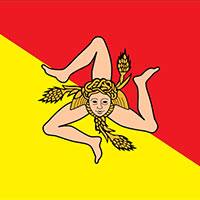Cefalù Cathedral (Duomo Basilica Cattedrale)
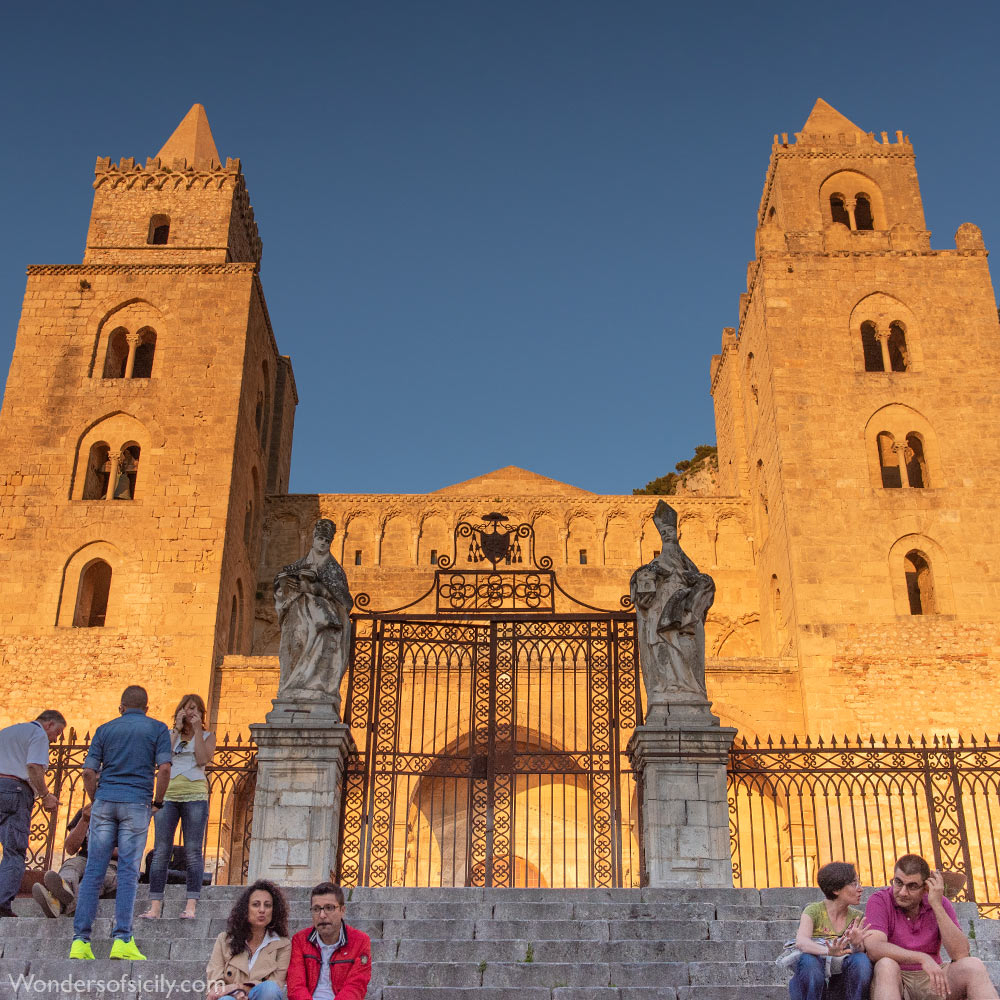
The cathedral in Cefalù during sunset is a breathtaking sight.
The Cefalù Cathedral, designated as a UNESCO World Heritage Site, stands as one of Sicily's most significant landmarks. Its distinctive architecture and breathtaking mosaics have earned it widespread acclaim. The cathedral's awe-inspiring location is enhanced by the majestic Rocca di Cefalù, which towers behind it.
Originally commissioned by Norman Roger II of Sicily in 1131, the cathedral remained unfinished upon his death in 1154. Unfortunately, subsequent rulers lost interest in its completion. Nonetheless, the interior of the cathedral stands as a testament to medieval art and architecture, showcasing a remarkable central nave flanked by two rows of columns adorned with captivating capitals.
Among its many remarkable features, the cathedral's Christ Pantocrator mosaic is particularly renowned. Enveloping the entire apse of the church, this mosaic is the earliest and best-preserved of its kind in Sicily. It is believed to have been crafted by Greek artisans summoned from Constantinople, radiating Christ's divine presence against a golden backdrop. Clutching an open book containing biblical text in both Greek and Latin, the mosaic depicts Christ in all his splendor. Quoting John 8:12, the text reads, "I am the Light of the World: he that followeth me shall not walk in darkness." Revered as one of the world's most exquisite works, similar breathtaking Pantocrator mosaics can also be admired at the Monreale cathedral, located just outside Palermo, and the smaller Cappella Palatina in Palermo.
Beneath the majestic figure of Christ Pantocrator, another captivating mosaic portrays the Virgin Mary surrounded by four archangels, each holding loaves of bread symbolizing salvation.
An inscription beneath the window indicates that the apse mosaics were completed in 1148. Undoubtedly, the cathedral stands as a true masterpiece of medieval art and architecture, an absolute must-visit for anyone exploring Sicily.
Adjacent to the cathedral lies the cloister, which stands as the oldest of its kind in Sicily. Unfortunately, a fire in 1809 resulted in the loss of the eastern side of the cloister. However, the northern colonnade remains intact, awaiting restoration to reclaim its original grandeur. It is believed that the same group of stonemasons also worked on the cloister in Monreale, further connecting these magnificent sites.
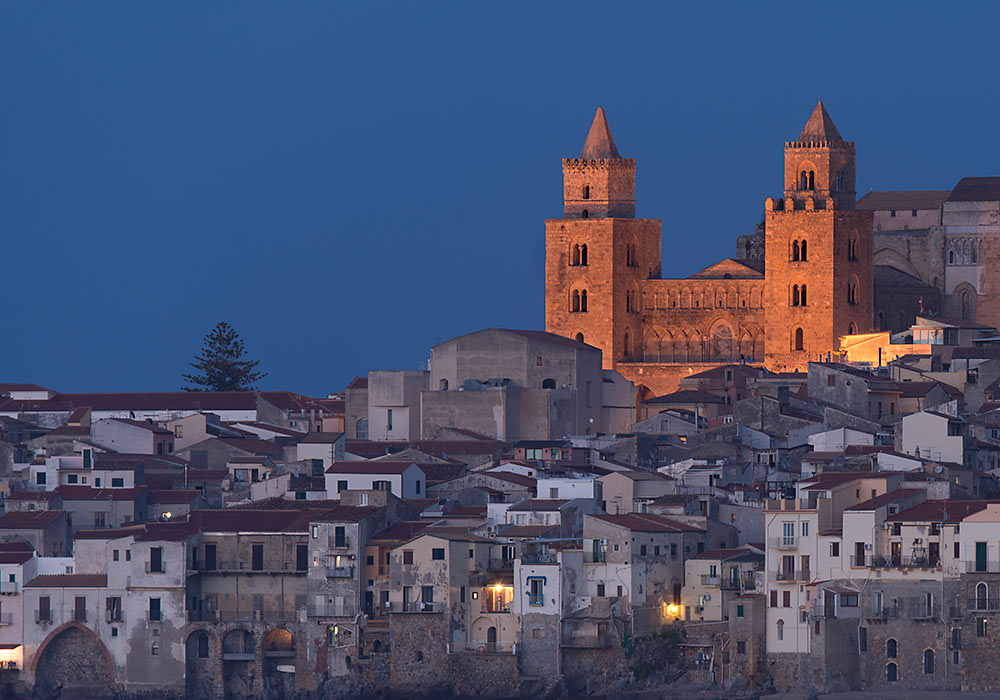
Cefalù with its magnificent cathedral. (ISO 100, f10, 6 sec)
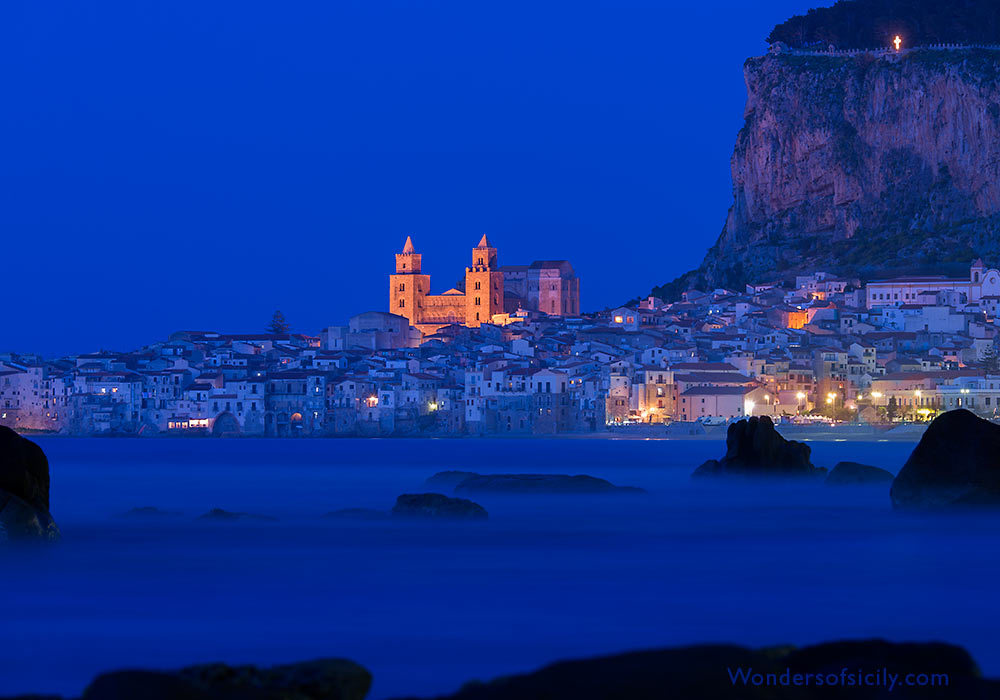
UNESCO’s World Heritage List
Arab-Norman Palermo and the Cathedral Churches of Cefalú and Monreale (Italy) - new on the list (2015)
Located on the northern coast of Sicily, Arab-Norman Palermo includes a series of nine civil and religious structures dating from the era of the Norman kingdom of Sicily (1130-1194): two palaces, three churches, a cathedral, a bridge, as well as the cathedrals of Cefalú and Monreale. Collectively, they are an example of a social-cultural syncretism between Western, Islamic and Byzantine cultures on the island which gave rise to new concepts of space, structure and decoration. They also bear testimony to the fruitful coexistence of people of different origins and religions (Muslim, Byzantine, Latin, Jewish, Lombard and French).
Palermo
- Palazzo dei Normanni (The Norman Palace)
- Cappella Palatina (The Palatine Chapel in the Norman Palace)
- Church of San Giovanni degli Eremiti
- Church of Santa Maria dell'Ammiraglio (also known as the Martorana)
- Church of San Cataldo
- Cathedral of Palermo
- The Zisa Palace (La Zisa)
- The Cuba Palace (La Cuba)
Norman Cathedrals
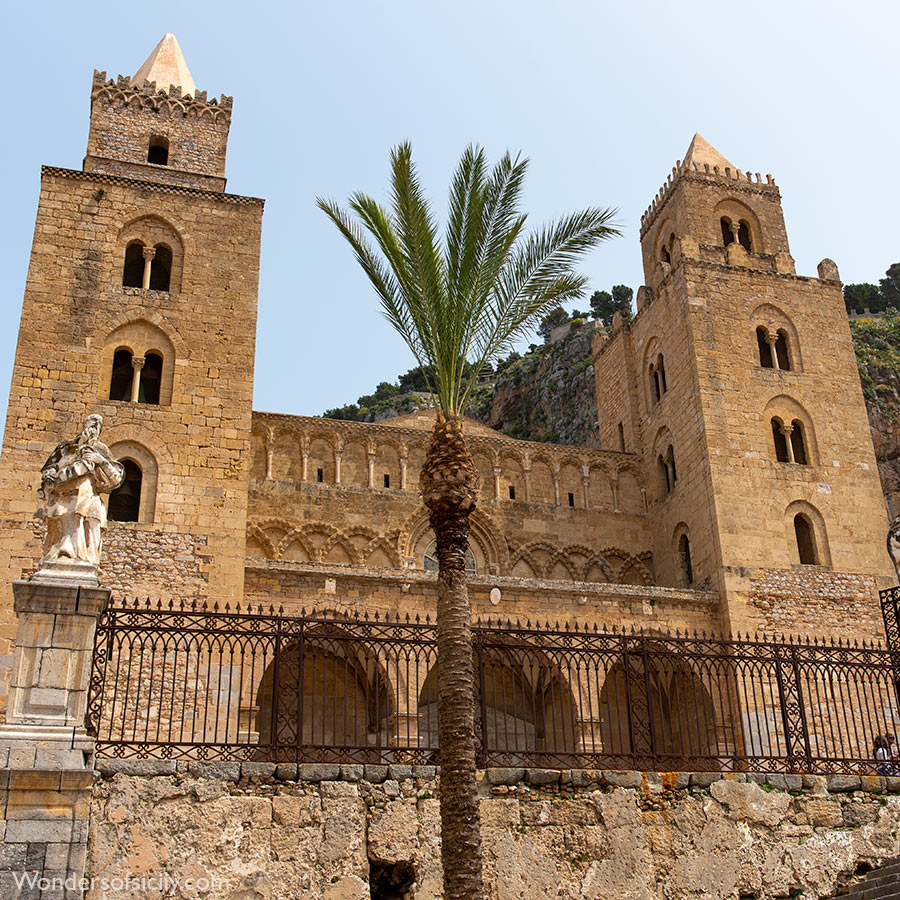
CLICK HERE to go to the main page about Cefalù!
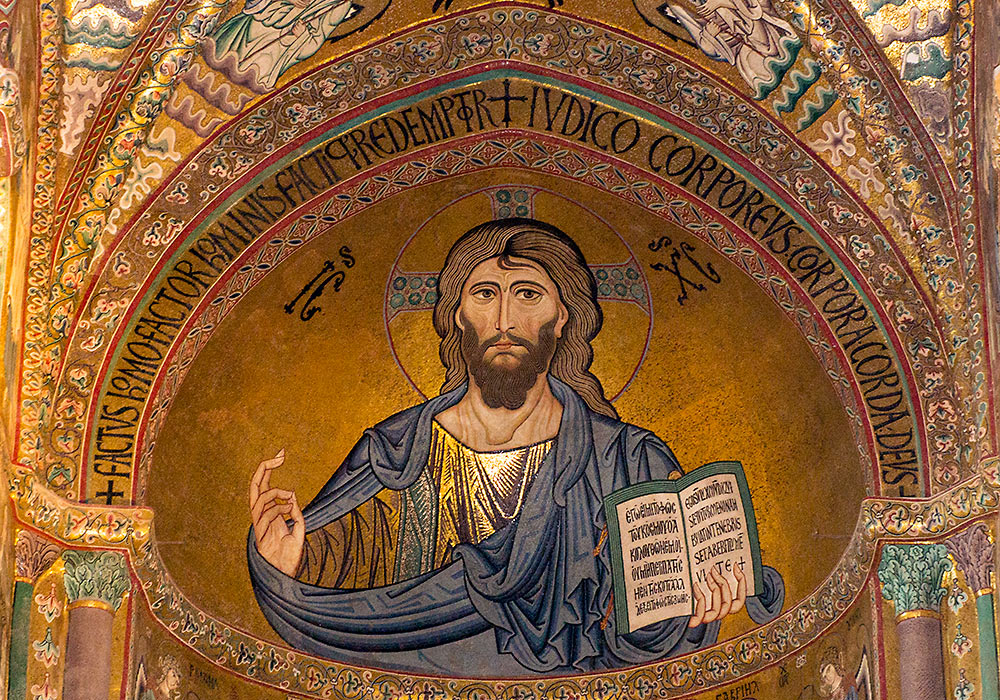
Christ Pantocrator in the Cefalù Cathedral. Jesus Christ is holding an open book with the Greek and Latin biblical text from John 8:12 (‘I am the Light of the World: he that followeth me shall not walk in darkness’).
According to the late historian John Julius Norwich (author of "The Normans in Sicily") the representation of the Pantocrator is the most sublime of all – "perhaps of Christ in any form in all Christian art". Construction began in 1131, the apse mosaics begun in 1145. After 1172 the church suffered a period of decline; the façade was completed in 1240. The Cathedral was consecrated in 1267 by Rodolphe de Chevriêres, Bishop of Albano.
Restoring Christ Pantocrator
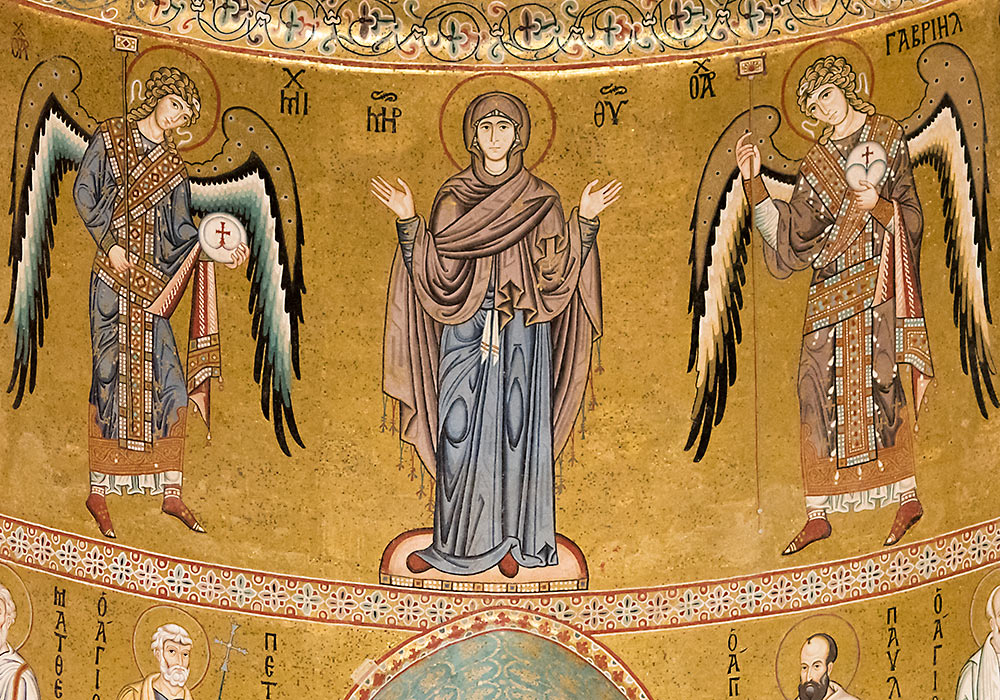
The Madonna flanked by archangels in the Cefalù Cathedral. The Enthroned Virgin in the Monreale Cathedral is vastly more elaborate. In Monreale, the Virgin is flanked by two archangels and two saints, whereas in Cefalù she is flanked by four archangels.
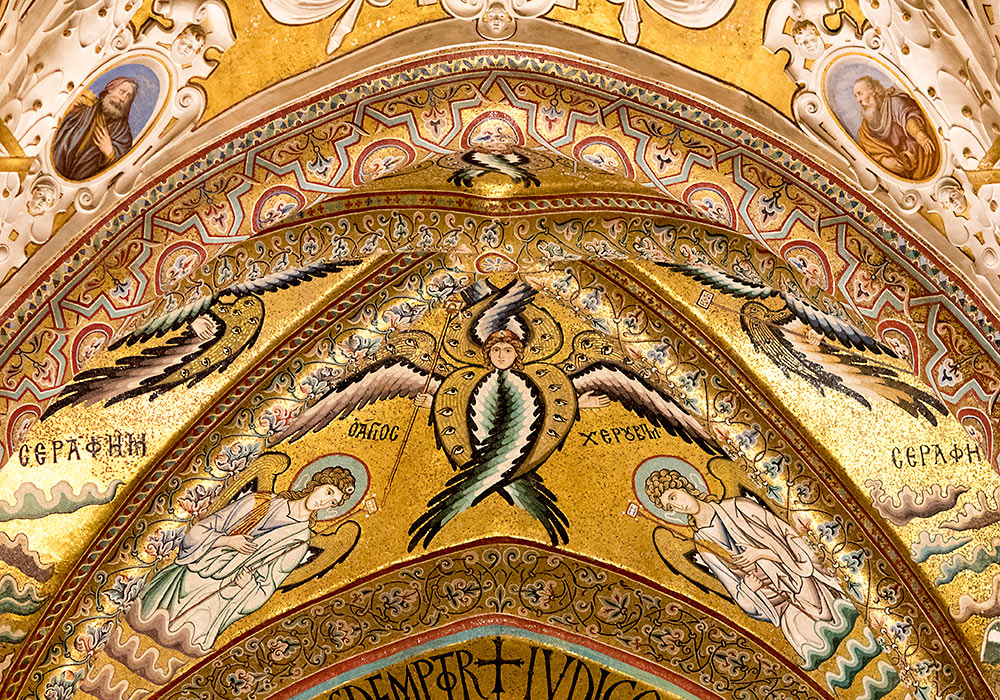
The mosaics above Christ Pantocrator. The baroque decorations start where the mosaics end.
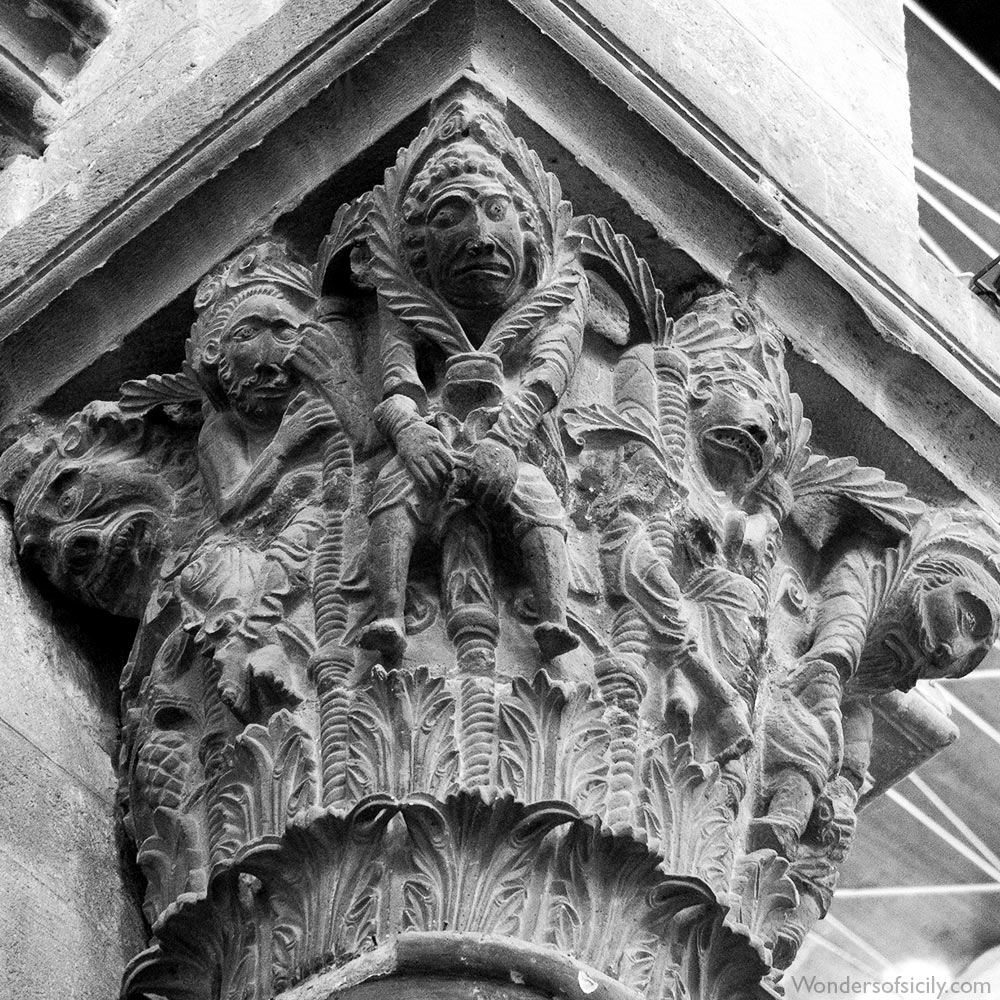
12th century capital in the Cefalù cathedral.
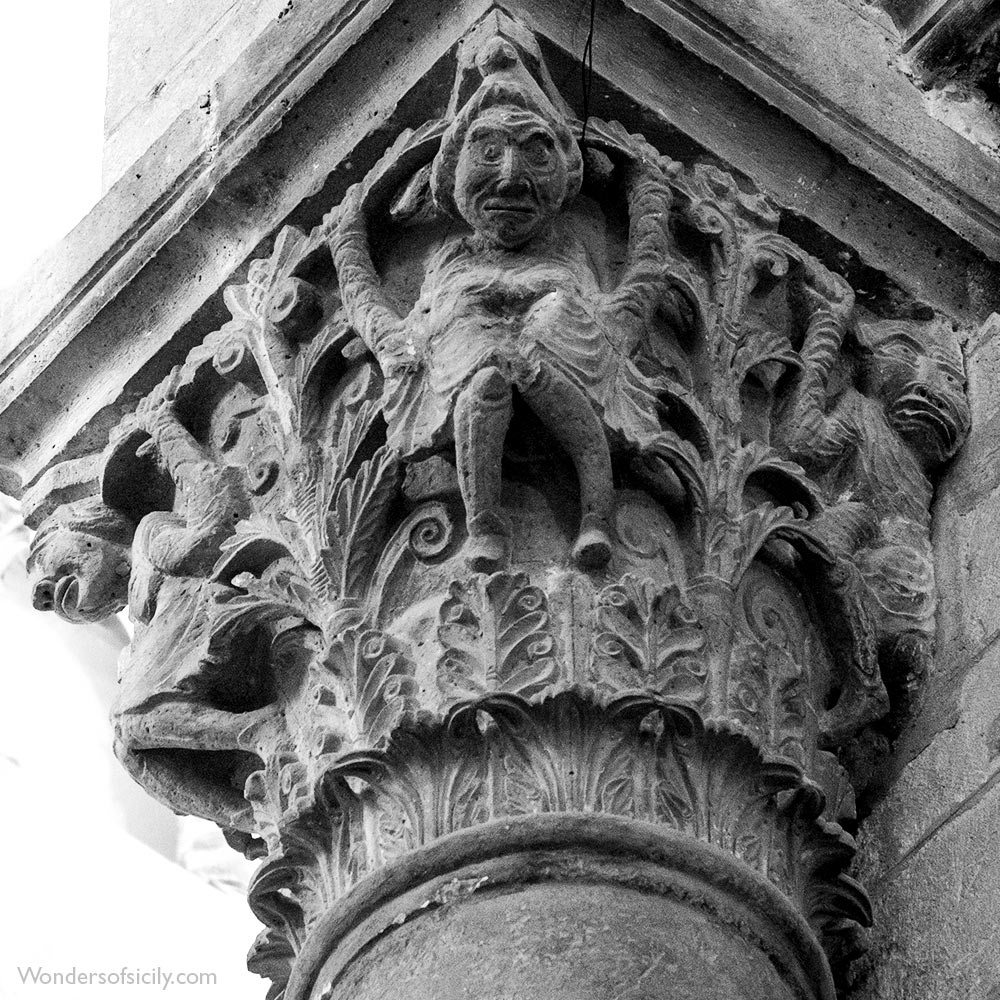
12th century capital.
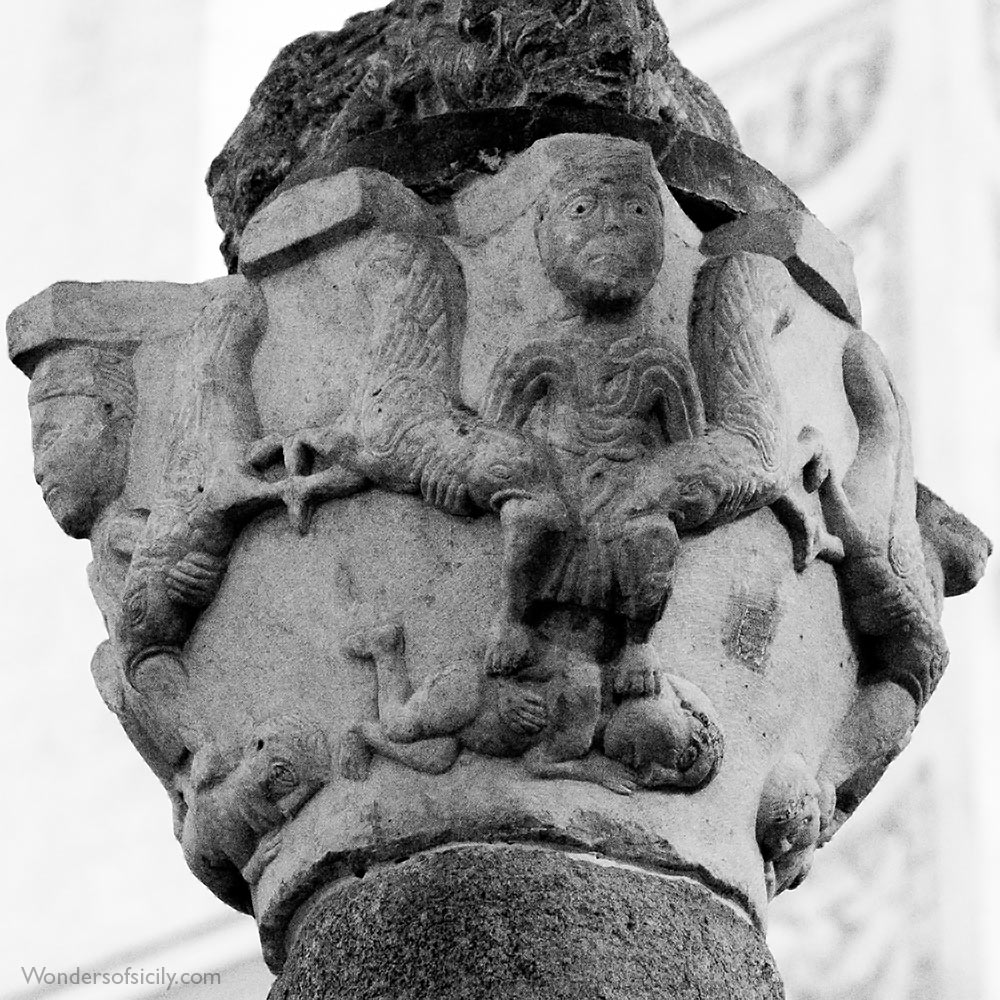
12th century capital of a column that originally stood the the cloister garden.
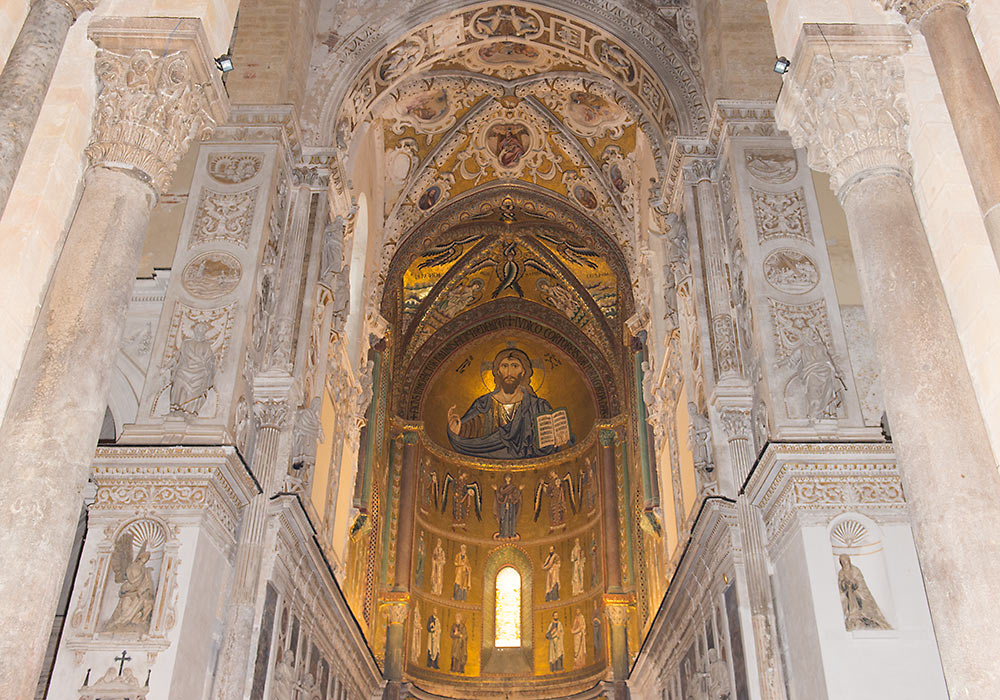
The mosaics are wrapped in baroque ornaments.
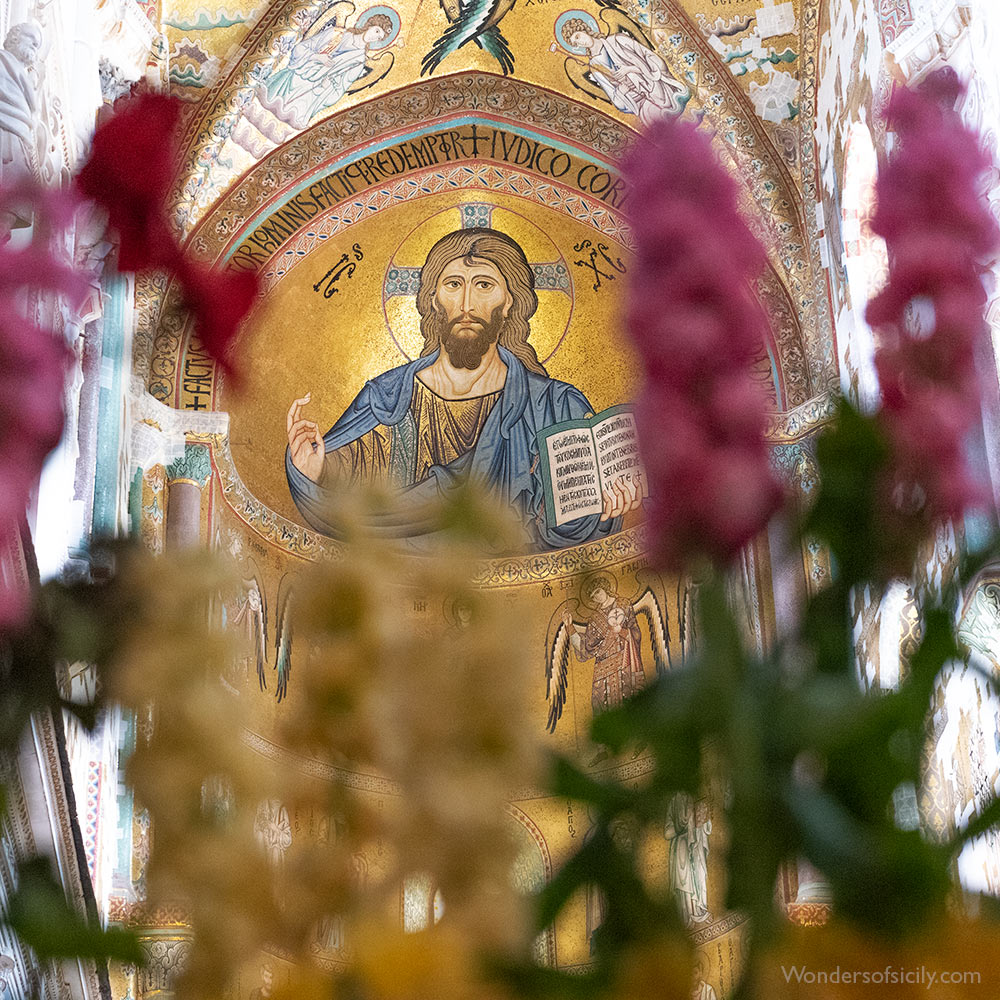
Christ Pantocrator. Mosaic, 12th century, Cefalù cathedral.
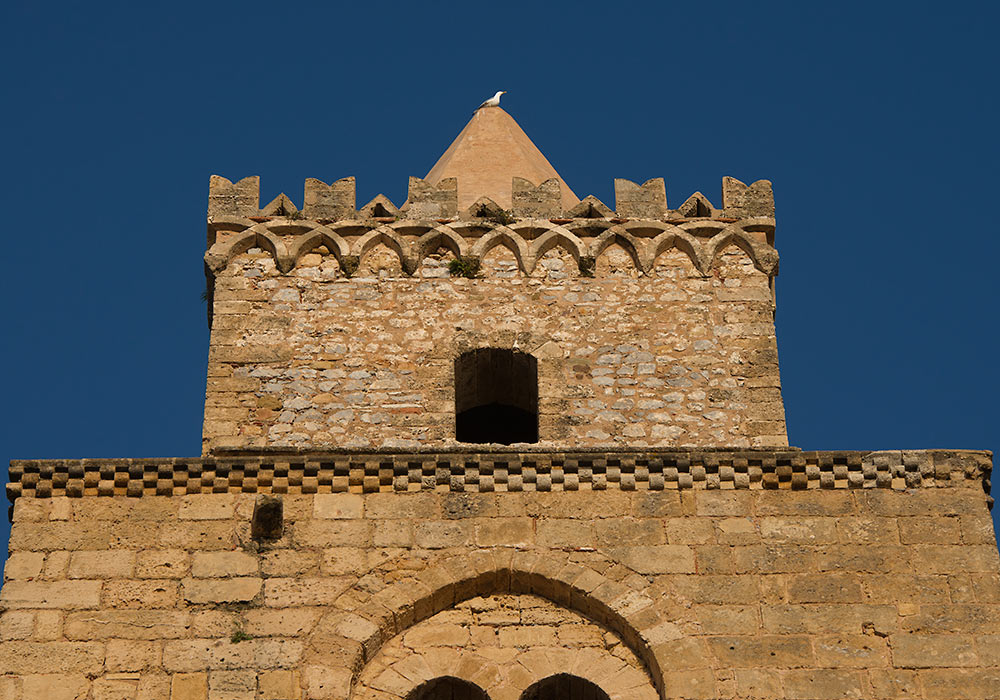
Detail of one of the bell-towers. The Cefalù cathedral was never finished, but is still an imposing building.
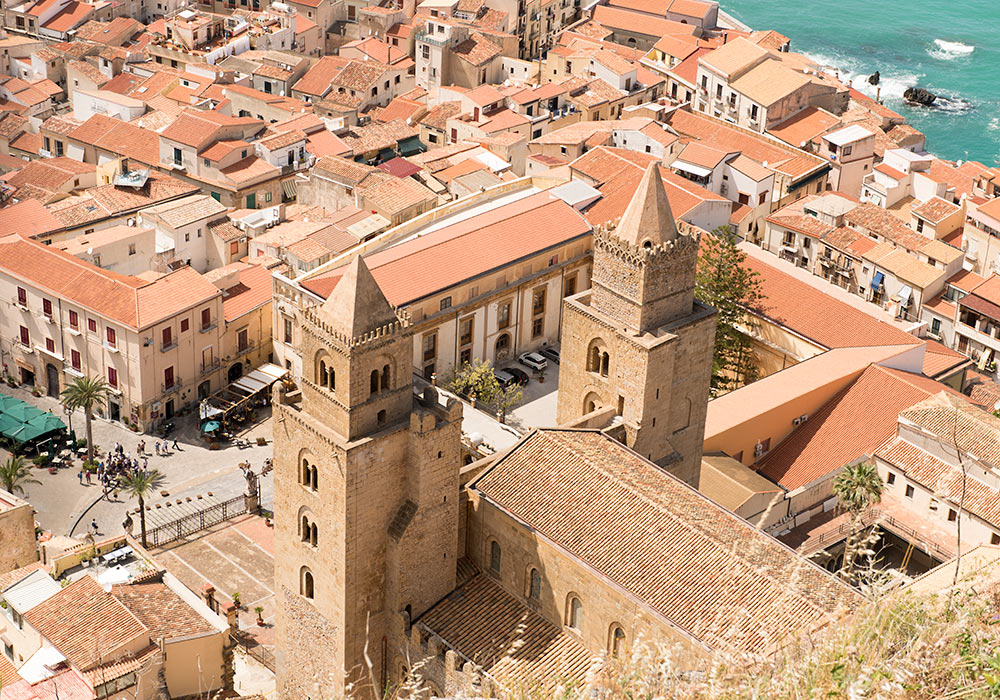
Cefalù with the Norman Cathedral seen from La rocca di Cefalù.
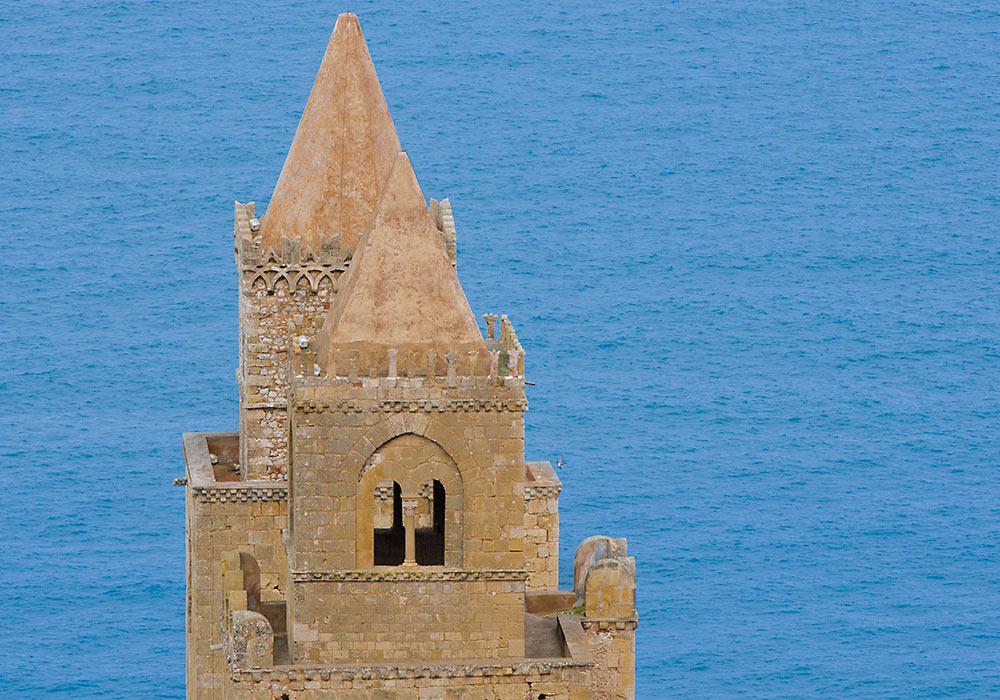
The bell-towers of the Cefalù Cathedral seen from La rocca di Cefalù.
CLICK HERE to go to the main page about Cefalù!
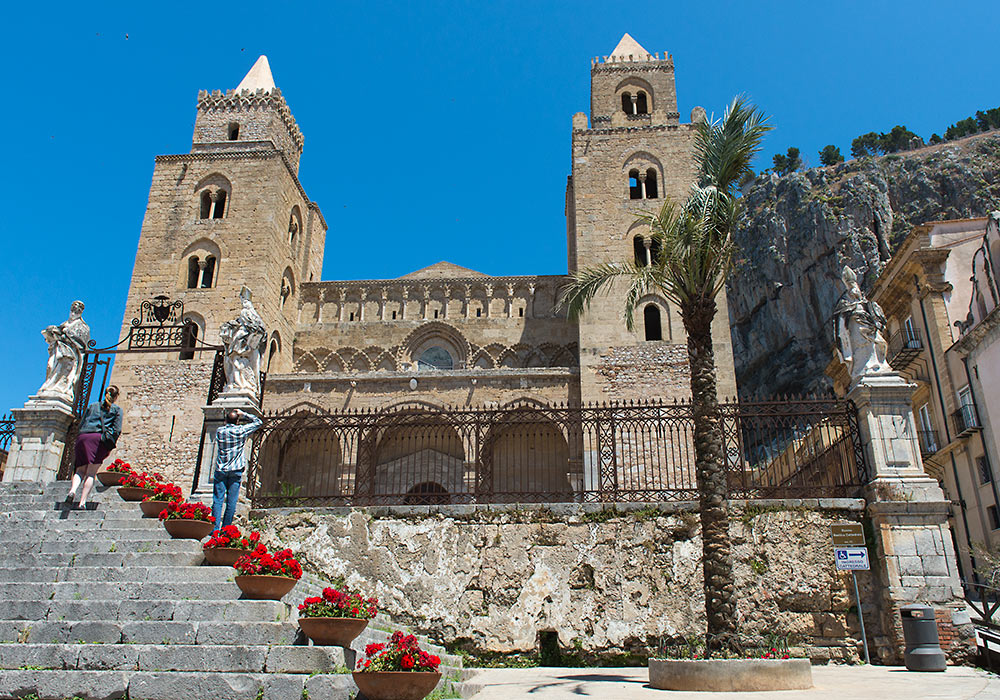
The Norman Cathedral is dramatically situated in front of the mountain called la Rocca di Cefalù. The Cathedral in Cefalù (Duomo Basilica Cattedrale) is one of Sicily's most important buildings from the Norman domination of the island. It was Roger II who started the construction in 1131.
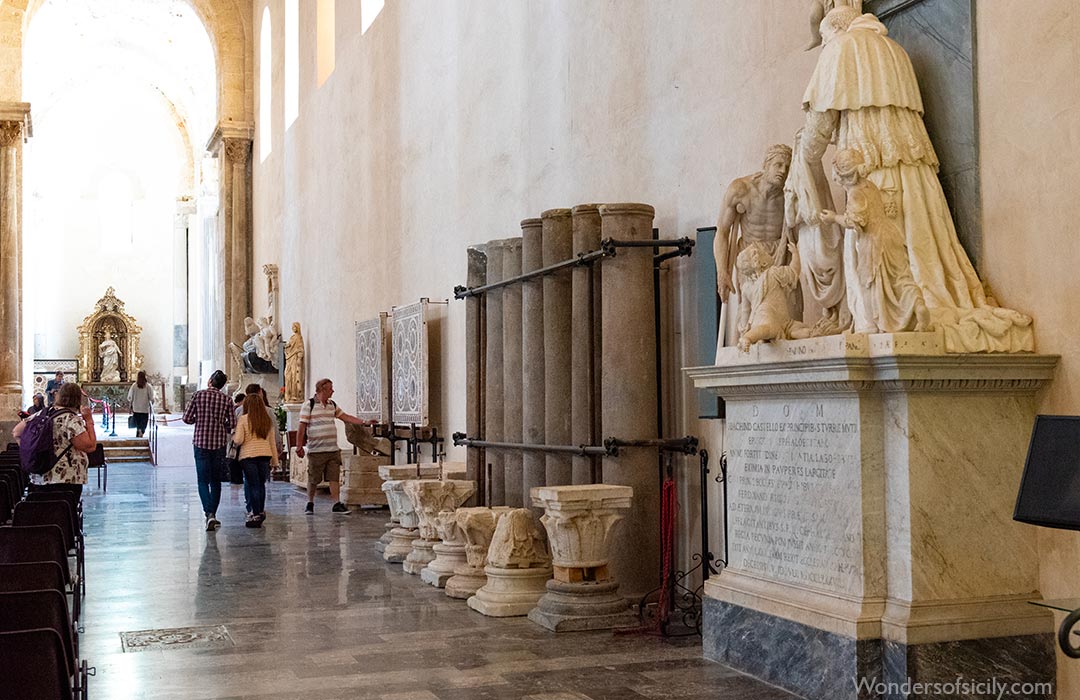
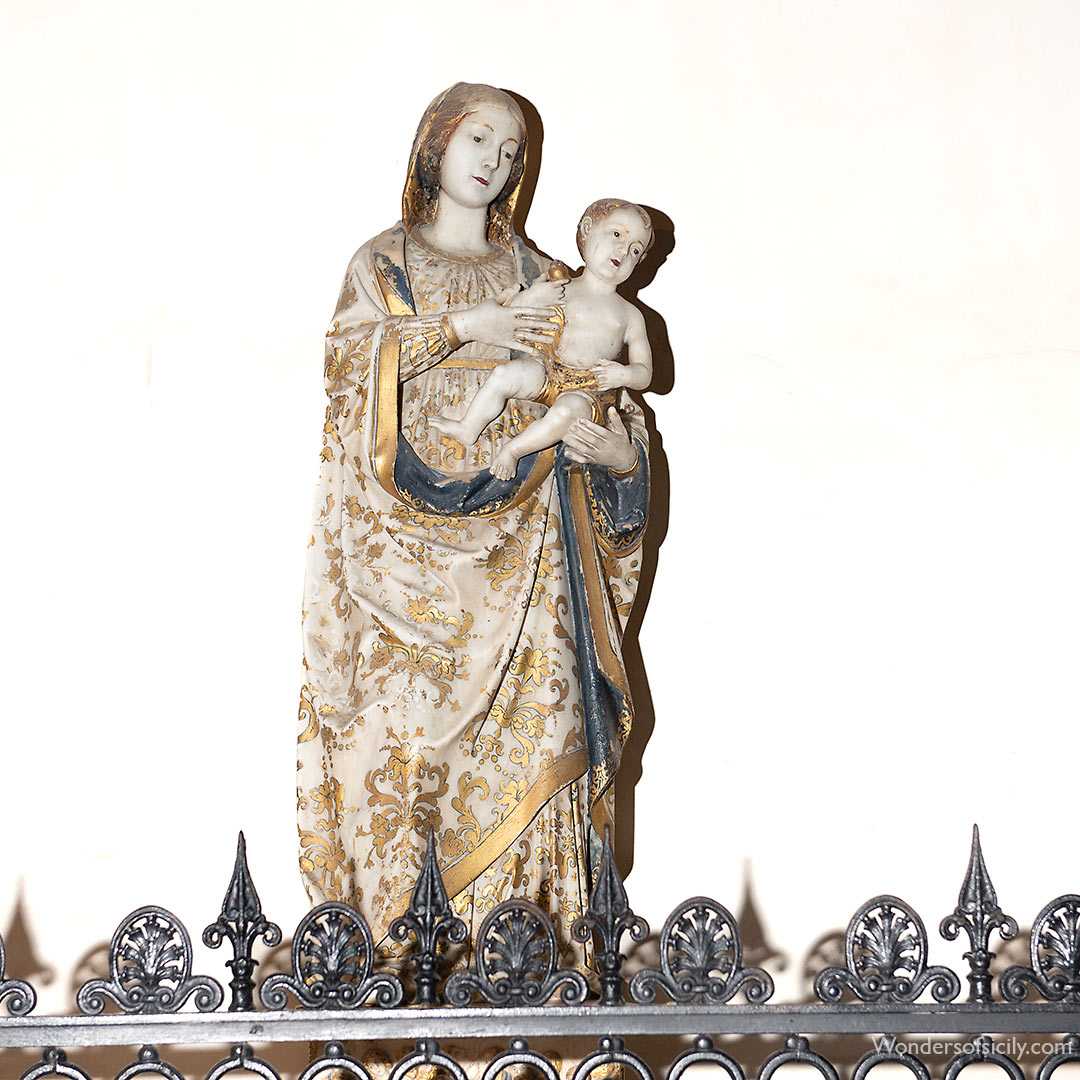
Madonna and Child was created in 1533 by Antonello Gagini (1478–1536). He was a pupil of his father Domenico and, like him, worked as a sculptor during the Renaissance. He continued his father's workshop in Palermo, where his five sons were also active. See below...
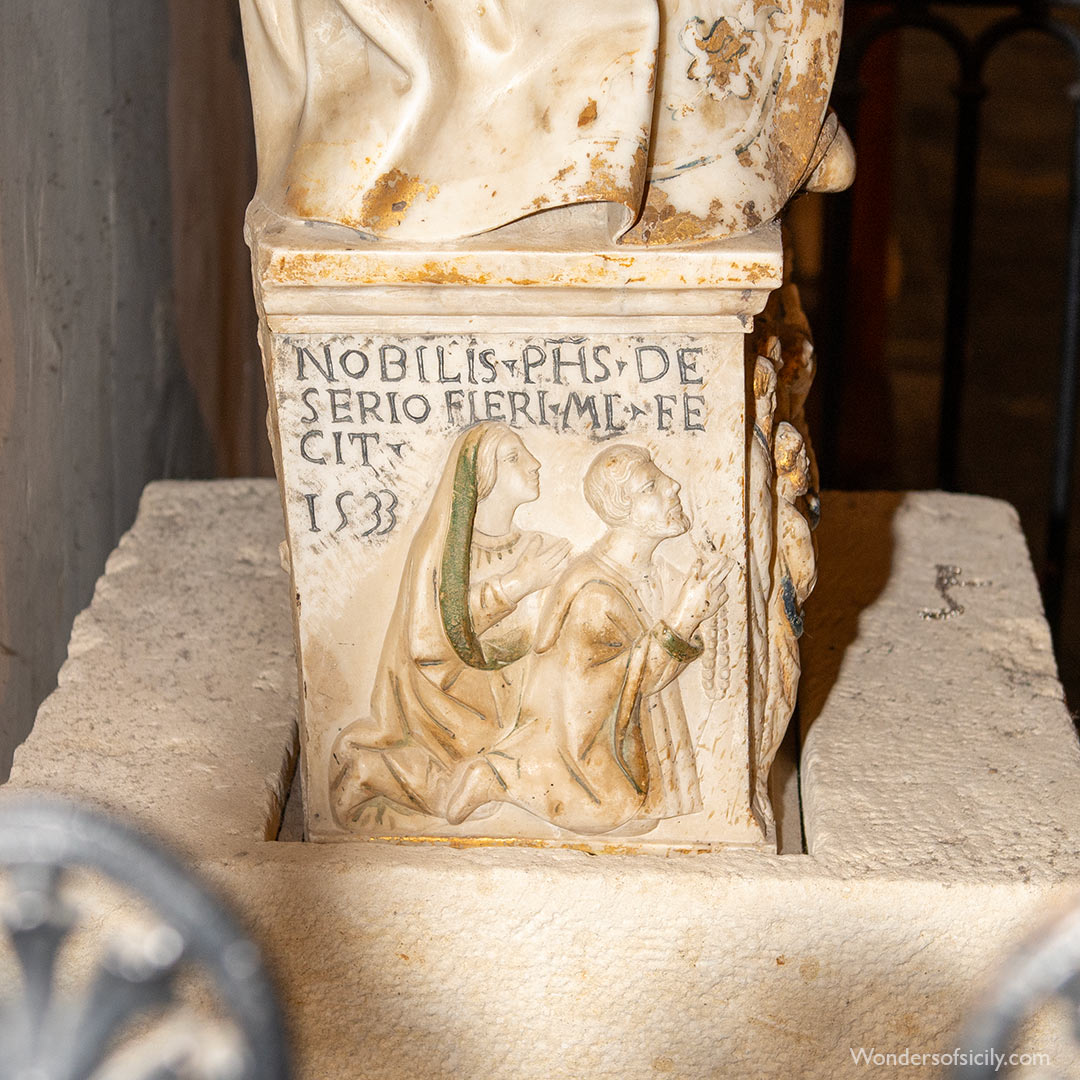
Nobilis PHS deserio fieri mi fecit. 1533 (“The noble PHS, desiring to be made [or become], created me. 1533”) – at the foot of the Madonna and Child. Is PHS the man who ordered the statue?
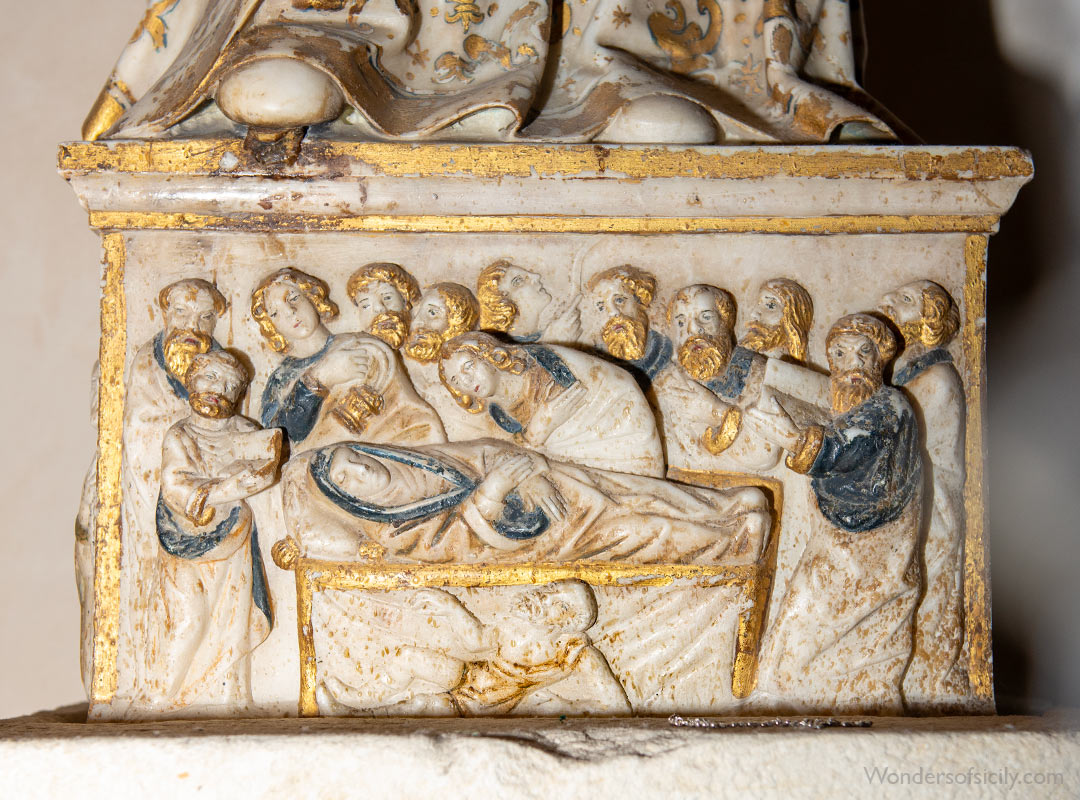
On another “panel” of the foot we find the dormition of Virgin Mary with a curious detail: a reclining man under her bed. My theory is that the man is PHS (see above), possibly the man who orderered the statue (??).
The depiction of a reclining man on funerary monuments was fashionable during the late Renaissance and Baroque periods (16th to 18th centuries). You'll find one in the garden of Villa Palagonia and in the Norman church called La Magione (Chiesa della Magione o della SS. Trinità).
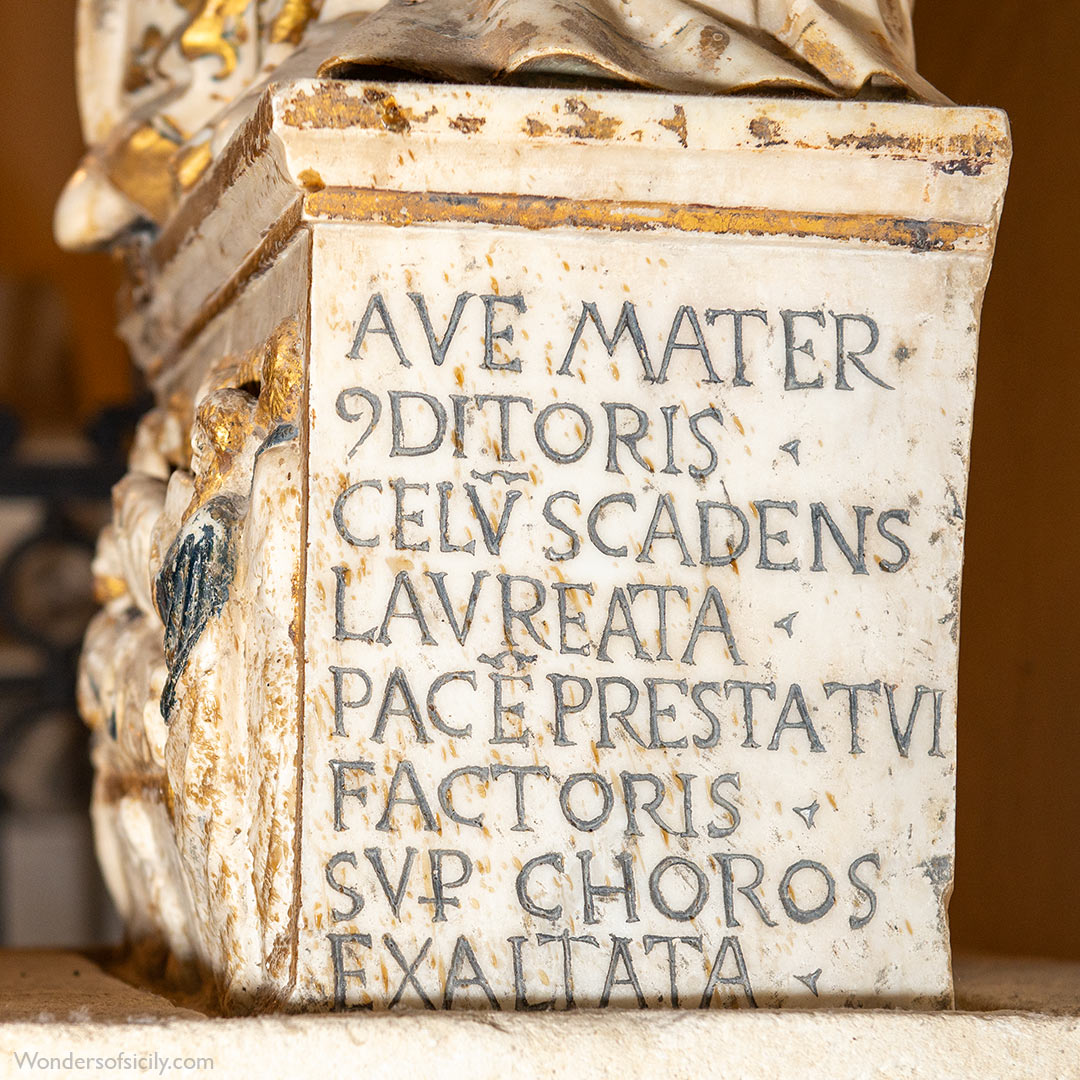
Hail, Mother of the Creator, descending from heaven, crowned with laurel, you bring the peace of the Creator. Exalted above the choirs [of angels]
The Latin should maybe be read as:
Ave mater Creatoris (meaning “Hail, Mother of the Creator”),
caelum scandens (meaning “ascending to heaven” or “descending from heaven”)
lavreata (meaning “crowned with laurel”)
pace prestatui factoris (likely meaning “you bring the peace of the creator”)
super choros exaltata (likely meaning “above the choirs [of angels]”)
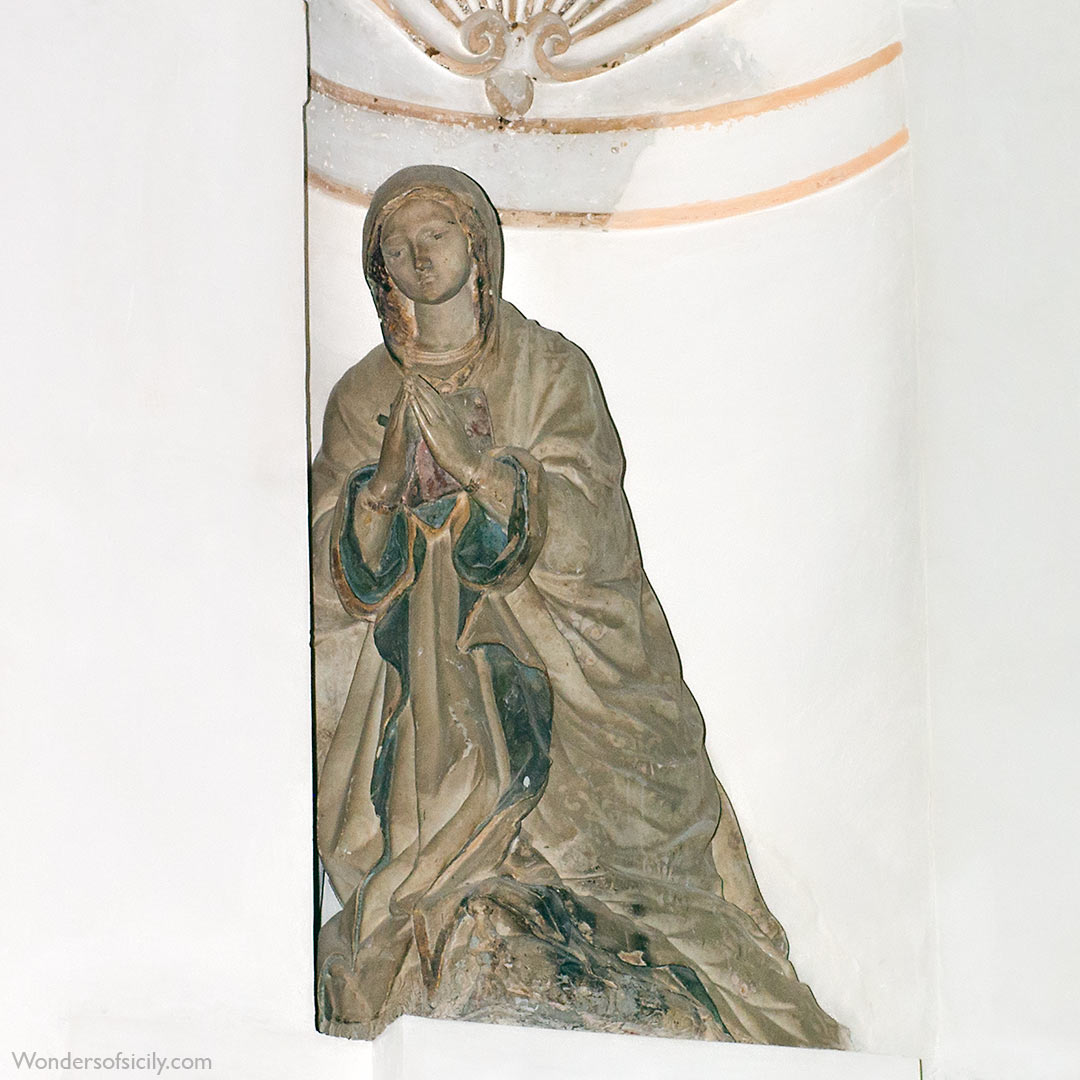
The Virgin Annunciate in a niche. (No date given. 15th century??)
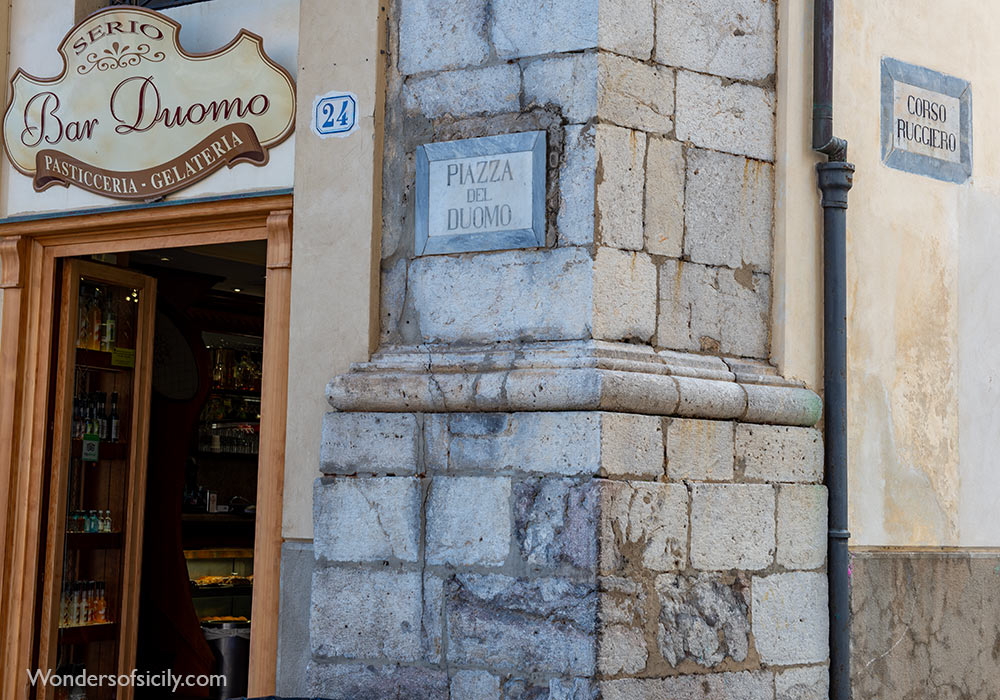
Corso Ruggiero / Piazza del Duomo.
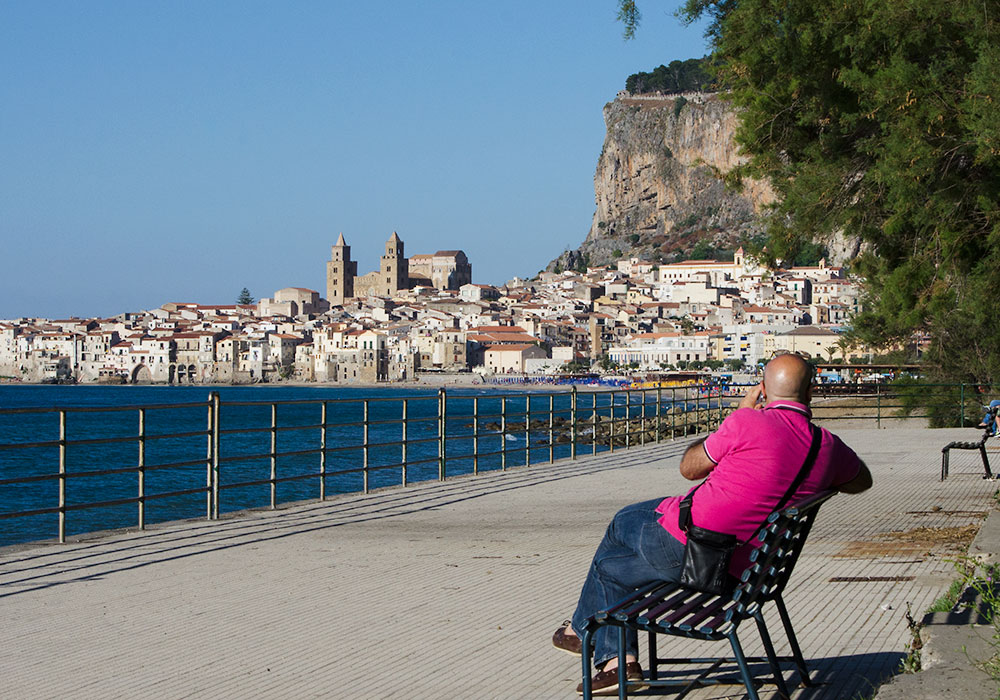
Cefalù with the stunning Norman cathedral. The cathedral was begun by Roger II in 1131, but was still unfinished at the time of his death in 1154. It was not consecrated until 1267. The presbytery is decorated with exquisite mosaics, the best preserved and the earliest of their kind in Sicily.
The term "Normans" (“men from the North”) applied first to the people of Scandinavia in general, and afterwards (Northmannus, Normannus, Normand) it is the name of the Viking colonists from Scandinavia who settled themselves in Gaul and founded Normandy. The Normans’ adopted a new religion (became Christians), a new language, a new system of law and society, new thoughts and feelings on all matters.
From their new home in northern France they set forth on new errands of conquest, chiefly in the British Islands and in southern Italy and Sicily.
If Britain and Sicily were the greatest fields of their enterprise, they were however very far from being the only fields. The same spirit of enterprise which brought the Northmen into Gaul seems to carry the Normans into every corner of the world. The conquest of England was made directly from Normandy, by the reigning duke, in a comparatively short time, while the conquest of Sicily grew out of the earlier and far more gradual conquest of Apulia and Calabria by private men, making their own fortunes and gathering round them followers from all quarters. They fought simply for their own hands, and took what they could by the right of the stronger.
They started with no such claim as Duke William put forth to justify his invasion of England; their only show of legal right was the papal grant of conquests that were already made. The conquest of Apulia, won bit by bit in many years of what we can only call freebooting, was not a national Norman enterprise like the conquest of England, and the settlement to which it led could not be a national Norman settlement in the same sense.
The Sicilian enterprise had in some respects another character. By the time it began the freebooters had grown into princes. Sicily was won by a duke of Apulia and a count of Sicily. Warfare in Sicily brought in higher motives and objects. Althought this was before the Crusades, the strife with the Muslims at once brought in the crusading element. Duke William was undisputed master of England at the end of five years; it took Count Roger thirty years to make himself undisputed master of Sicily. The one claimed an existing kingdom, and obtained full possession of it in a comparatively short time; the other formed for himself a dominion bit by bit, which rose to the rank of a kingdom.
Professor Robert Bartlett describes their exit like this in the excellent BBC documentary “The Normans”: “The Normans simply disappeared. This might sound like failure, but in fact it was the key to their success. They weren’t interested in the purity of their blood. They came, they saw, they conquered. Then they married the locals, learnt the language, and assimilated themselves out of existence.”
Links to more information about the Normans
- The Norman Conquest (Medievalsicily.com)
- Sicilian Peoples: The Normans by L. Mendola and V. Salerno (Bestofsicily.com)
- Tracing the Norman Rulers of Sicily by Louis Inturrisi (The New York Times)
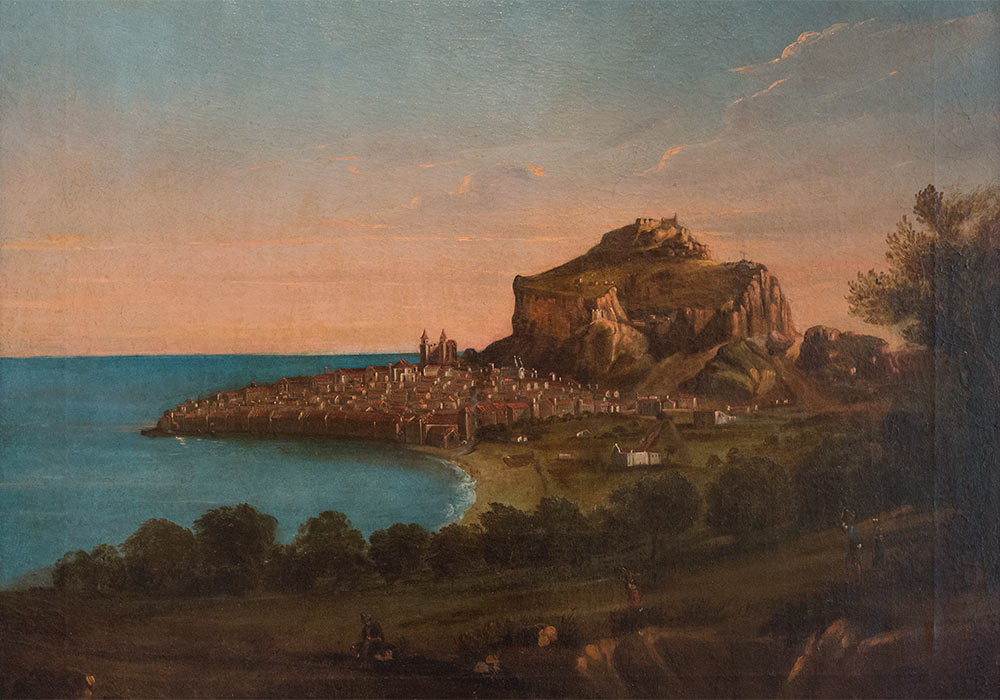
Cefalù certainly was a beautiful city even in the mid 1800's. Here a detail of a painting hanging in the Museo Mandralisca in Cefalù. It was painted by Francesco Tenuta Bevelacqua (1814-1858).
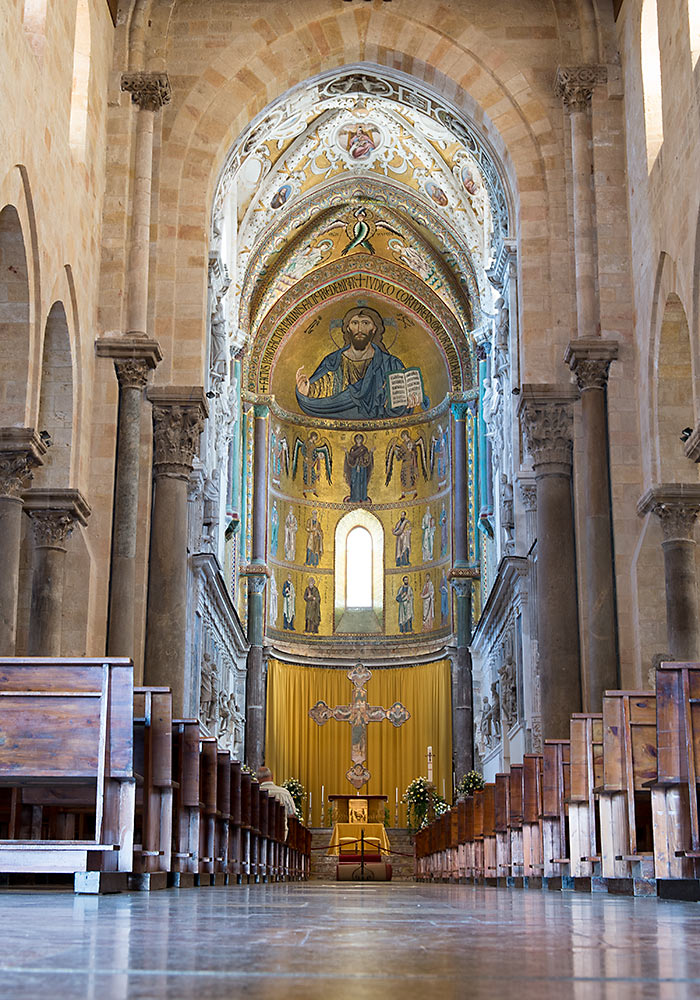
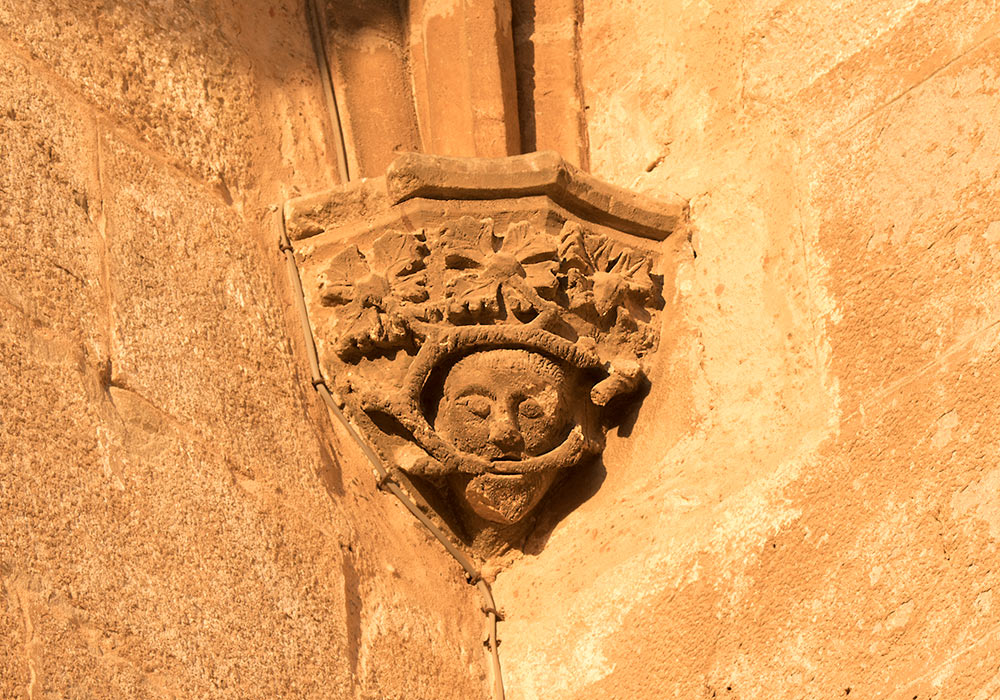
Cefalù Cathedral (detail of the exterior).
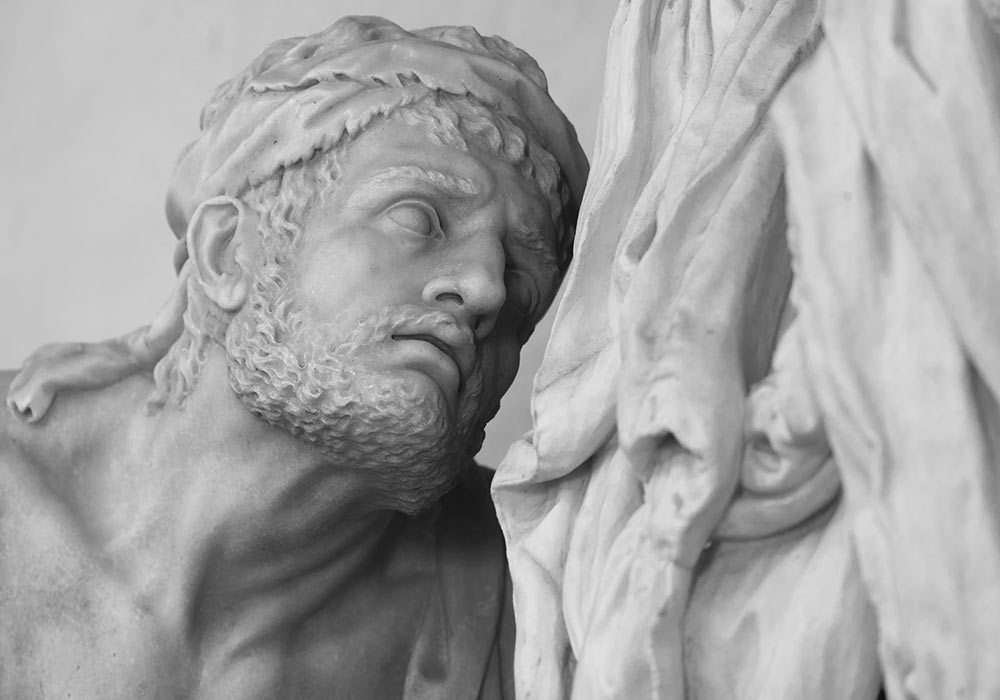
Baroque statue (detail of leper) in the Cefalù Cathedral.
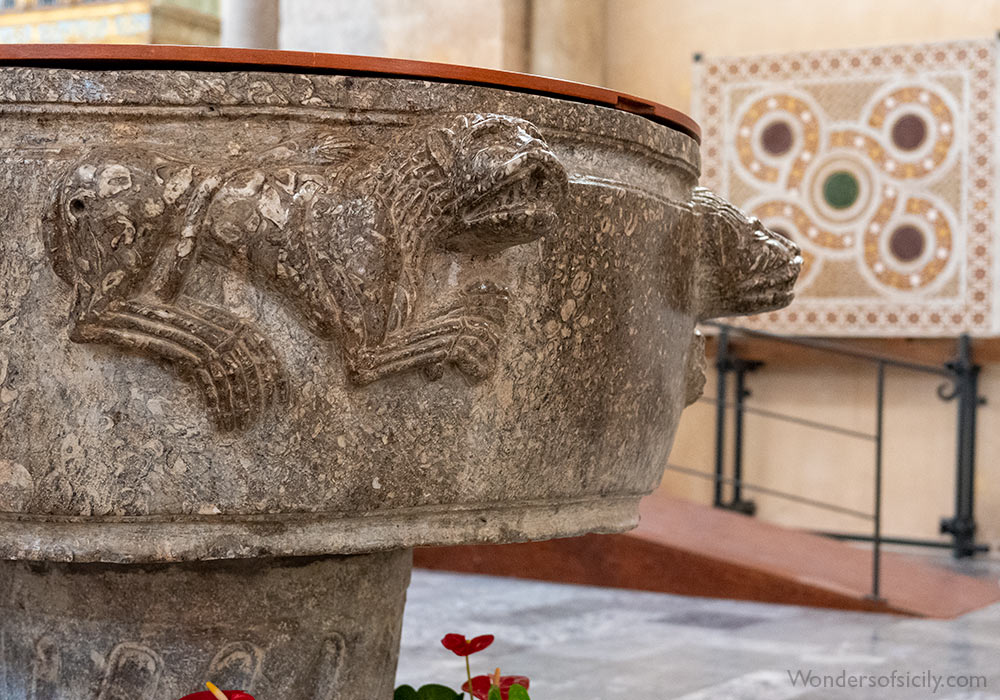
12th century Romanesque baptismal font with lion reliefs.
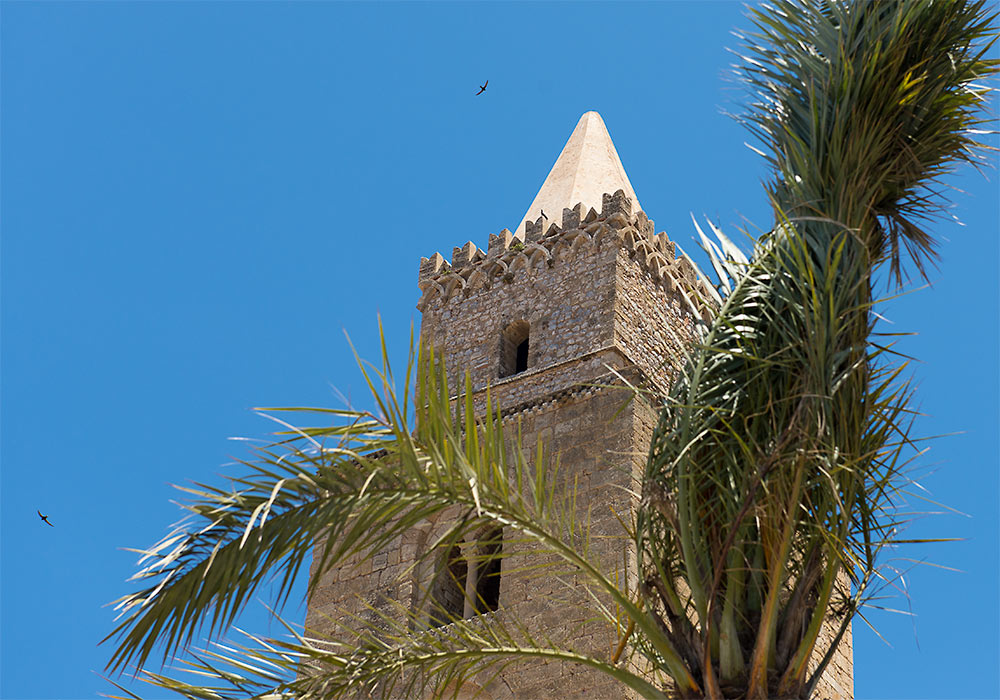
Cefalù Cathedral - one of the towers.
CLICK HERE to go to the main page about Cefalù!

